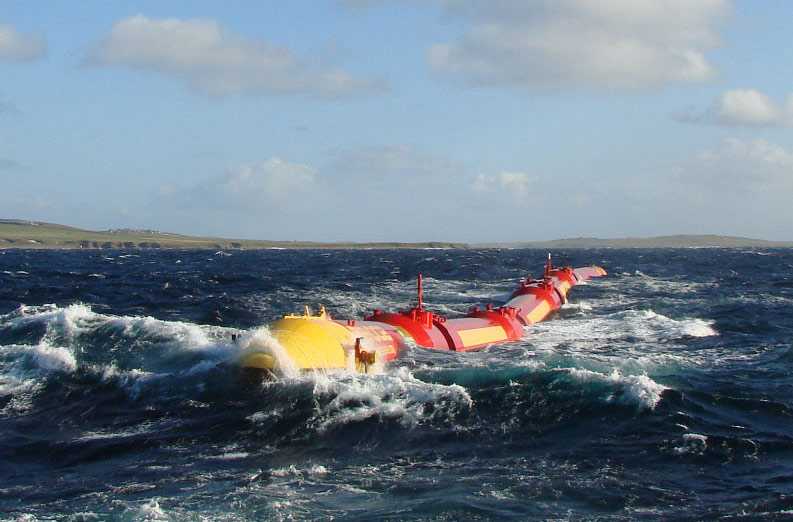Is Wave Energy the Ideal Option for Power Generation in Bangladesh?

Renewable energy is
extensively spoken about in the modern world, as it is limitless, which means
it’s sustainable and does not produce greenhouse gasses that are harmful to the
environment and human health. A standard illustration of renewable energy is
wave energy.
Wave energy is a
renewable energy whereby the energy that is captured being produced naturally
by waves. Waves get their energy from the wind passing over the surface of the water
i.e. sea as well and can convey their energy over long distances with little
degradation; wave energy is considered a substantial renewable energy source.
Image: The UK's first wave energy plant will produce enough energy for 6,000 homes.
According to
Conserve Energy Future, the pursuit of wave energy dates all the way back in
1799 when Girard and his sons filed a patent to utilize wave energy in Paris.
The modern pursuit of wave energy went all the way to the Empire of Japan in 1940
when it was developed by Yoshio Masuda, a former Japanese naval commander, who
was regarded as the father of modern wave energy technology. Wave energy only
gained popularity after the 1963 oil crisis when Professor Stephen Hugh Salter
invented the eponymous Salter duck wave energy device that was able to convert
90% of wave motion into electricity, generating 80% efficiency.
The irregular
and oscillating flow of wave energy in oceans – kinetic energy as it is called
– has tremendous energy potential and if harnessed could provide a tremendous
addition to a clean energy system. The energy in a wave is determined and
calculated by wave height, speed, length, and the density of the water. Though
most wave technologies are intended to be installed near the ocean’s surface,
they can be used in nearshore, offshore, and far offshore locations depending
on where the resources lie.
Image: Capturing the Motion of the Ocean
When wind blows across the sea surface, it transfers the energy to the waves. They are powerful source of energy. The energy output is measured by wave speed, wave height, wavelength and water density. The more strong the waves, the more capable it is to produce power. The captured energy can then be used for electricity generation, powering plants or pumping of water. It is not easy to harness power from wave generator plants and this is the reason that they are very few wave generator plants around the world.
Though with the
high potential for energy source, wave energy has some drawbacks also. Wave
energy is irregular which can create problems with absorption rates and Wave
energy devices need to withstand major oceanic assaults such as storms and
saltwater corrosion. Currently wave power is very expensive to the point where
it is not yet competitive with fossil fuel energies.
Image: National
Renewable Energy Laboratory (NREL)’s novel WEC design
Apart from the drawbacks, wave energy has many more advantages. The most important advantage of wave energy is renewable and reliable. Waves are a material that cannot be used up like other conventional forms of energy such as oil, natural gas, and coal, and we won’t run out of waves any time soon.
The energy
density of waves along shorelines is approximately 30-40 kW/m of waves, and
further out into the ocean, most waves can generate 100 kW/meter of
electricity. Less than ½ mile2 of ocean has the potential to generate more than
30 MW of power.
While wave
energy devices can be built near shorelines, they can also be built offshore,
which reduces shoreline conflicts of use such as recreation and fishing. Once
they have been built, wave energy devices can be free to operate by themselves,
unless the equipment malfunctions or damage occurs. Wave energy devices can be
installed to be mostly or entirely submerged beneath the water. The devices can
be installed far enough from shore to allow for minimal visual impact. Because
wave energy uses no fuel, this dramatically lowers the cost of device
operation.
Unlike oil
spills and pollution and death from fossil fuels like coal, there is virtually
no pollution from the generation of electricity from waves. Wave energy devices
can be tailored to meet electricity demand, and therefore can be manufactured
at different sizes that are appropriate for each location. In contrast, fossil
fuels generally require large facilities in order to produce electricity.
Bangladesh with the shortage of energy and having large area of ocean water, wave energy can be a very substantial renewable energy source.
Author: Ahsanul Haque
Copyright © Strategy for Environmental Development Foundation 2017, all rights reserved.



